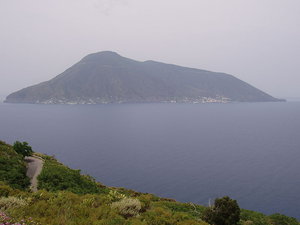Difference between revisions of "Salina"
m |
m |
||
| Line 1: | Line 1: | ||
| − | + | {{X}} | |
| + | [[Image:Salina_view_from_Lipari.jpg|thumb|right|300px|A view of Salina from Lipari. The near peak is ''Fossa delle Felci''.]] | ||
| − | + | '''Salina''' is the second largest of the seven [[Aeolian Islands]], after [[Lipari]], with a total surface area of 27 km². The island is formed by six inactive [[volcano|volcanoes]], the two youngest and tallest of which are named ''Fossa delle Felci'' ("Fern Hollow") (962 m) and ''Monte dei Porri'' (860 m). In the [[Ancient_Greece|Hellenic Age]], the island was named "Didyme" (Δίδυμη), a Greek name which refers to the two mountains as "twins". The modern name comes from the production of [[sea salt]] which was performed at the southern tip of the island. | |
| − | + | Salina is the most fertile of the Aeolian isles, and [[grape|grapes]] grown on Salina are used to make [[Malmsey|Malvasia]] [[wine]]. The local variety is called ''Malvasia delle Lipari''. The island also exports [[capers]] and caperberries internationally. | |
| − | + | There are three principal towns on Salina: ''[[Santa Marina Salina|Santa Marina]]'', ''[[Malfa]]'' and ''[[Leni]]''. The island was inhabited as far back as the [[Bronze_age#Aegean_Bronze_Age|Bronze Age]] and has been developed and then abandoned many times over the subsequent millennia. In 1544, when [[Spain]] declared war on [[France]], the French king [[Francois I]], asked the [[Ottoman Empire|Ottoman]] [[Sultan]] [[Suleiman the Magnificent|Suleiman]] for help. The latter sent a fleet headed by Khair ad Din (A.K.A."[[Barbarossa Khair ad Din Pasha|Barbarossa]]") who was victorious over the Spaniards, and managed to retake [[Naples]] from them. In the course of the battle, the Aeolian Islands were depopulated. Later immigrants from mainland Italy, Sicily and Spain re-established communities on Salina. Areas on the island, including the two mountain peaks, were designated as a [[nature_reserve|natural reserve]] in 1981. There are currently approximately 2300 residents living in Salina. [[Michael Radford]]'s film [[Il Postino]] was partly shot on Salina. | |
| − | |||
| − | |||
| − | |||
| − | + | ||
| − | *[[ | + | |
| − | + | ==See also== | |
| + | *[[List of volcanoes in Italy]] | ||
| + | |||
| + | |||
| + | ==External links== | ||
| + | *[http://www.estateolie.it/salina.htm Aeolian Island tourism website (in Italian).] | ||
| + | *[http://iles_eoliennes.blog.lemonde.fr blog about Salina] | ||
| + | |||
| + | [[Category:Aeolian Islands]] | ||
| + | [[Category:Islands of Italy]] | ||
| + | [[Category:Volcanoes of Italy]] | ||
Latest revision as of 00:30, 20 November 2008
Salina is the second largest of the seven Aeolian Islands, after Lipari, with a total surface area of 27 km². The island is formed by six inactive volcanoes, the two youngest and tallest of which are named Fossa delle Felci ("Fern Hollow") (962 m) and Monte dei Porri (860 m). In the Hellenic Age, the island was named "Didyme" (Δίδυμη), a Greek name which refers to the two mountains as "twins". The modern name comes from the production of sea salt which was performed at the southern tip of the island.
Salina is the most fertile of the Aeolian isles, and grapes grown on Salina are used to make Malvasia wine. The local variety is called Malvasia delle Lipari. The island also exports capers and caperberries internationally.
There are three principal towns on Salina: Santa Marina, Malfa and Leni. The island was inhabited as far back as the Bronze Age and has been developed and then abandoned many times over the subsequent millennia. In 1544, when Spain declared war on France, the French king Francois I, asked the Ottoman Sultan Suleiman for help. The latter sent a fleet headed by Khair ad Din (A.K.A."Barbarossa") who was victorious over the Spaniards, and managed to retake Naples from them. In the course of the battle, the Aeolian Islands were depopulated. Later immigrants from mainland Italy, Sicily and Spain re-established communities on Salina. Areas on the island, including the two mountain peaks, were designated as a natural reserve in 1981. There are currently approximately 2300 residents living in Salina. Michael Radford's film Il Postino was partly shot on Salina.
See also
